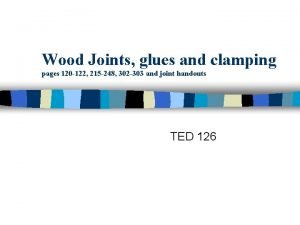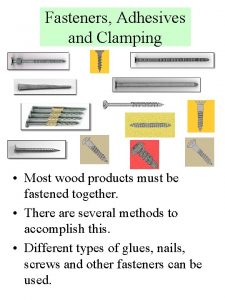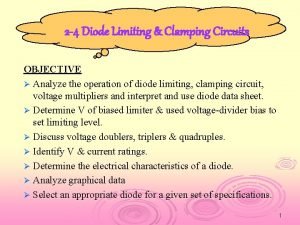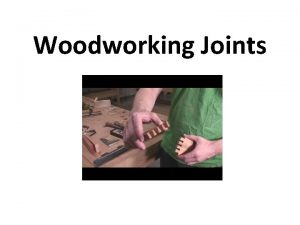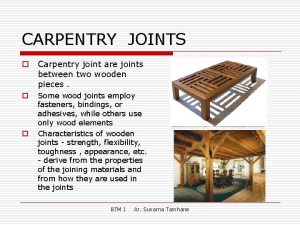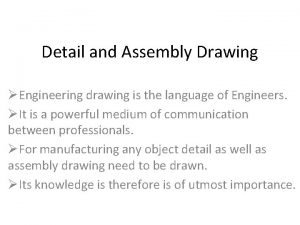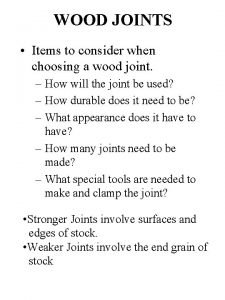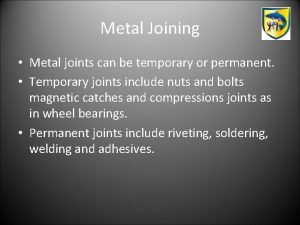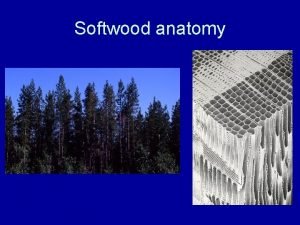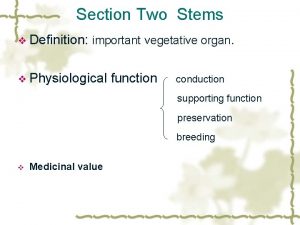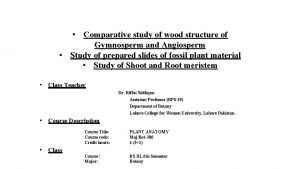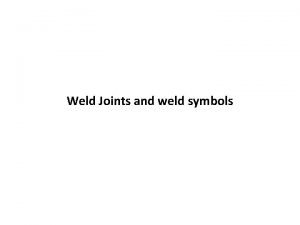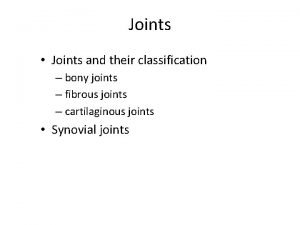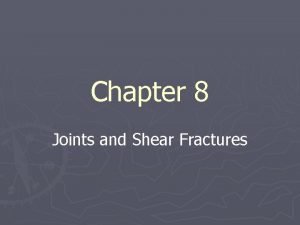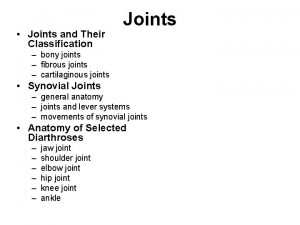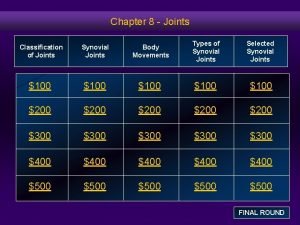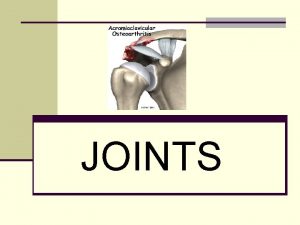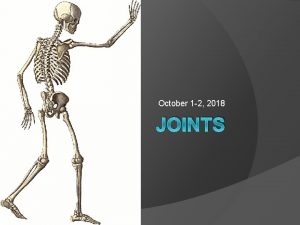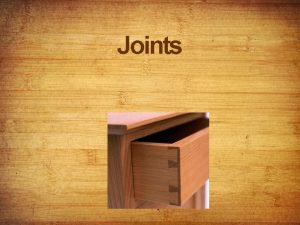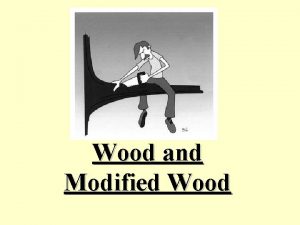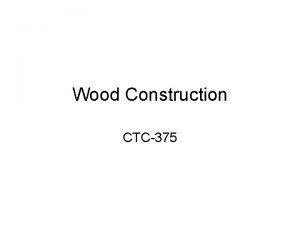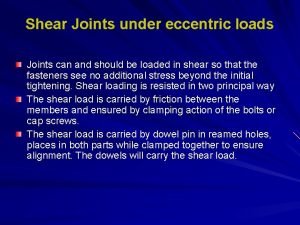Wood Joints and clamping Wood Joints n jointsthis


























- Slides: 26

Wood Joints and clamping

Wood Joints n “joints”…this term is used to describe the close securing or fastening together of two or more smooth, even surfaces.

Wood Joints n The joint to select for each kind of construction depends to some extend on the need for: – The strength – The appearance – The difficulty of fabrication – The equipment available

Wood Joints n Most joints are permanently fastened together with glue and sometimes screws or nails.

Wood Joints n The following are common methods of strengthening joints. – Dowels – Splines and Biscuits – Key – Glue Blocks – Corner Blocks

Wood Joints n The following are common methods of strengthening joints. – Dowels You can put a dowel into butt, miter, lap joints etc. to add strength to the joint.

Wood Joints n The following are common methods of strengthening joints. – For a Spline to add strength to a joint, its grain must run across the joint, not parallel to it.

Wood Joints n The following are common methods of strengthening joints. – Biscuits – Using thin wood wafers called biscuits can strengthen wood joints by providing more glue bonding area. Biscuit will expand 2 X. – You can use a biscuit joiner (also called a plate joiner) to cut precision mating slots in boards for the biscuits.

Wood Joints n The following are common methods of strengthening joints. – Key

Wood Joints n The following are common methods of strengthening joints. Glue Block-small triangular or square blocks Corner Blocks-larger than a glue block

Eight basic wood joints 1. 2. 3. 4. 5. 6. 7. 8. Edge Butt Rabbet Dado Miter Lap Mortise and Tenon Dovetail

Eight basic wood joints • Edge-to-edge: • This joint is used when laminating boards together edge-to-edge to obtain a wider piece of wood. Used for table top, desktops and cabinet sides. •

Eight basic wood joints • Butt • For simple boxes, cases, cheap drawers, frames and chairs. Very weak joint. •

Eight basic wood joints • Rabbet- A cut or groove along or near the edge of a piece of wood that allows another piece to fit into it to form a joint. Lshaped groove cut across the edge or end of one piece. • For simple boxes, cases, cheap drawers, frames and chairs • • It is usually reinforced with screws or nails. Rabbet joints are easy to make and moderately strong. They are used chiefly for boxes, drawers, shelving and at the corners of cabinet pieces. Rabbet joints are sometimes made with a dado variation.

Eight basic wood joints • Dado- is a groove cut across the grain. • • typically used in making book shelves, drawers, steps, and book cases. This is a strong joint. In very old furniture, a dovetail dado joint is a real work of art because of the time the cabinetmaker had to spend to cut it.

Eight basic wood joints • Miter- the joining pieces are cut at a 45 -degree angle and joined to form a right angle. • Miters are used for decorative molding and for frames. • They are very weak and are often reinforced with dowels, spline, or mechanical fasteners. Polygon miters- cuts at angles of more or less than 45 degrees to form three- to ten-sided objects.

Eight basic wood joints • • • Lap joints are really a large group of joints in which one side laps over the other. A cross-lap joint joins two pieces with flush faces. The pieces may cross at any angle. Cutting dadoes of equal width and depth on the two pieces so that the face surfaces are flush when they are assembled makes the joint. Used for legs of furniture, doors, furniture frames and braces. This joint is strong.

Eight basic wood joints Mortise and Tenon n One of the most common joints used for joining the rails and legs of tables, chairs and other type of furniture is the Mortise and Tenon joint.

Mortise and Tenon A large range of mortise and tenon joints exist and the most simple of these is shown. The tenon is the part that fits into the mortise. A glue is applied before the joint is pushed together. Clamps are used to hold the joint firmly together, usually for twenty-four hours.

Mortise and Tenon The Plain Mortise and Tenon joint (shown below) is very common and is widely used for the joints of tables. n Although it is quite strong, if enough force is placed on the joint it will eventually break or come lose. n

Mortise and Tenon The Wedged Mortise and Tenon joint is extremely strong because the tenon passes all the way through the mortise and is wedged at the other side. n However, the Wedged Mortise and Tenon is more difficult to mark out and cut and requires much more technical skill. n

Mortise and Tenon n In this example, a piece of dowel rod is drilled through the mortise and the tenon. n This helps keep the joint together even when it is under great pressure. n This is used as a joint on chairs and other pieces of furniture so that the joints do not break apart when extra weight is applied.

Eight basic wood joints n The DOVETAIL JOINT is very strong because of the way the tails and pins are shaped. n This makes it difficult to pull the joint apart and virtually impossible when glue is added. n This type of joint is used in box constructions such as draws, jewellery boxes, cabinets and other pieces of furniture where strength is required. n There are different types of dovetail joint and when cut accurately they are very impressive and attractive.

Finger Joints n It is ideal for box constructions and is suitable for use with natural woods such as pine and mahogany or even manmade boards such as plywood and MDF. n The joint is strong especially when used with a good quality glue.

Basic Clamping Systems n n n n Hand Screw or Wooden Parallel Clamps Steel Bar or Cabinet Clamps Wood Bar Clamps Spring Clamps C or Carriage Clamps Quick, Band, Hinged Clamps Miter-and-Corner Clamps

Basic Clamping Systems
 Glue
Glue Chapter 9 adhesives gluing and clamping
Chapter 9 adhesives gluing and clamping Clamping diode definition
Clamping diode definition Obturator and kelly clamp
Obturator and kelly clamp Feces
Feces Clamping åbenrå
Clamping åbenrå Chapter 7 wood joints
Chapter 7 wood joints Wood joining methods
Wood joining methods Ways of making permanent joints
Ways of making permanent joints What is a widening joint
What is a widening joint Assembly technical drawing
Assembly technical drawing Types of joints wood
Types of joints wood What is a temporary joint
What is a temporary joint Fusiform rays
Fusiform rays V
V Esharenet
Esharenet Esau wood poem
Esau wood poem Wood wood teenager
Wood wood teenager Weld symbol arrow side
Weld symbol arrow side Joints and links
Joints and links Faults and folds
Faults and folds Sheet metal groove lock
Sheet metal groove lock Figure 6-2 structure of a typical bone
Figure 6-2 structure of a typical bone Self-secured joints
Self-secured joints Five basic welding joints
Five basic welding joints Fiber joint
Fiber joint Why is carcase meat prepared into cuts joints and mince
Why is carcase meat prepared into cuts joints and mince
